3 August 2007, Chicken Beach
Written 10 August 2007
On Friday was the all-day outing to Porto de Galinhas, "Port of the Chickens," attached to the town of Ipojuca. Apparently, early in the period when importation of slaves was illegal in Brazil, slavers put into this more secluded port, an hour by bus south of Recife, under cover of delivering "galinhas de Angola," literally "Angola chickens" but actually meaning guinea fowl, I'm told. When a shipment arrived, messengers were sent north to Recife to alert those who might be interested, and the word was discretely passed around town that "the chickens have arrived," and those interested in bidding on the slaves would travel to Porto de Galinhas under cover of darkness.
The folks in the area are very poor, and local authorities hit on the idea of developing Porto de Galinhas as a beach resort. They've been pretty successful—we saw souvenirs of the place as far as away as the airport giftshops in Rio. Our usual Martur guides explained all this during the bus trip, and they took care to point out that, yes, inviting resort companies to come build large complexes did damage the environment somewhat, but on the other hand, the only other employment in the region (aside from a little fishing) is in the canefields, and for each ton of cane harvested, the cutter received just 7 reais (about $3.50), about a tenth of what he'd need each month to keep a small family alive. Each resort hotel, though, employs at least 240 people, and in addition, Porto de Galinhas now has 160 smaller guest houses, each of which employs several.
We piled into our tour buses once again, at 8:30 a.m., and headed south. Once we cleared Recife, most of the land was in sugar cane. Even before the guide told us, it was clear that it must all be planted, cultivated, and harvested by hand, because the terrain is so steep and hilly; I couldn't imagine any kind of machinery being used on it. At borders of cane fields were rows of what I think were papaya trees, and around the scattered houses, I saw banana trees, mango trees, and a few plantings of Eucalyptus. A few black vultures (the same ones we have in North America; I'm told they have turkey vultures here, too) circled overhead, and I spotted one great egret in a roadside ditch.
When we arrived in Porto de Galinhas, our bus was stopped at the edge of town (vehicles that large aren't allowed any further), and our guides led us in a troop the half-dozen blocks to the beach. In the yard of the gas station where we left the bus was a very large, very tall, but rather sickly-looking tree bearig yellow flowers and 4-inch, green, sausage-shaped fruits. I asked what it was, and for once, somebody knew—a sapote. Turns out there are many kinds of sapotes, and I don't know which this was.
The whole beach-side veranda of a large seafood restaurant had been reserved for us for the day, and our lunch would be served there at 1 p.m. The tour guides promised to sit right there guarding our stuff while we went off to amuse ourselves. The choices were (1) raft rides out to the offshore reefs, where holes in the reef form natural "swimming pools" and tropical fish abound (these are not the sort of "coral reefs" we usually picture but flat, stony surfaces exposed at low tide but submerged at high tide, like those in Recife but bigger; (2) beach-buggy rides to the mangrove areas (the beach buggies were old Volkswagen beetle chassis with open, jeep-like bodies on top); (3) the usual-beachy type activities, including swimming, wading, snorkeling, sunbathing, and whatnot; and (4) strolling around the town looking at giftshops (at least 6 out of every 7 businesses). We opted initially for the last.
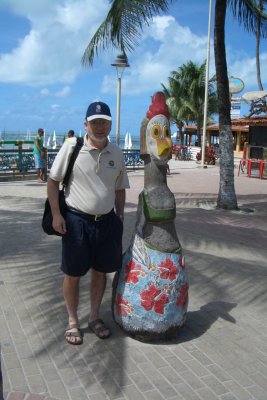
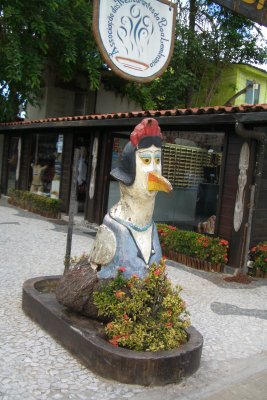 Now when you set out to build a name as a beach resort, you need a trademark theme, and somehow "last slave port in Brazil" didn't seem right, but chickens, now—everybody likes chickens! So chickens it is. Everything in town is shaped like, or decorated with, chickens (except the public trash containers, which are shaped like seashells). Some are faithful to the globular shape and black-speckled-with-white color scheme of guinea fowl, but apparently any old kind of chicken will do. You can buy carved chickens (of all sizes and shapes), stuffed chickens (ditto), chicken fridge magnets (double ditto), dozens and dozens of different patterns of chicken-bedecked t-shirts, chicken buckets and spades, chicken chess and checker sets, chicken-headed bar tools and fondue forks. The restrooms are marked with fanciful pictures of
roosters and hens. Palm-tree bases carved into the shapes of chickens are everywhere (here are a couple, with David next to one for scale). Some of the phone booths are shaped like chickens (rather malevolent-looking ones, I thought; here one shares a pole with another of those coconut shaped ones). Strangely, there's no KFC or local equivalent that I could spot, and we saw no actual live chickens (seems as though a few free-run jungle fowl would be a natural, like the ones at the San Diego Zoo, which patrol the paths for edible litter, like french fries and popcorn).
Now when you set out to build a name as a beach resort, you need a trademark theme, and somehow "last slave port in Brazil" didn't seem right, but chickens, now—everybody likes chickens! So chickens it is. Everything in town is shaped like, or decorated with, chickens (except the public trash containers, which are shaped like seashells). Some are faithful to the globular shape and black-speckled-with-white color scheme of guinea fowl, but apparently any old kind of chicken will do. You can buy carved chickens (of all sizes and shapes), stuffed chickens (ditto), chicken fridge magnets (double ditto), dozens and dozens of different patterns of chicken-bedecked t-shirts, chicken buckets and spades, chicken chess and checker sets, chicken-headed bar tools and fondue forks. The restrooms are marked with fanciful pictures of
roosters and hens. Palm-tree bases carved into the shapes of chickens are everywhere (here are a couple, with David next to one for scale). Some of the phone booths are shaped like chickens (rather malevolent-looking ones, I thought; here one shares a pole with another of those coconut shaped ones). Strangely, there's no KFC or local equivalent that I could spot, and we saw no actual live chickens (seems as though a few free-run jungle fowl would be a natural, like the ones at the San Diego Zoo, which patrol the paths for edible litter, like french fries and popcorn).
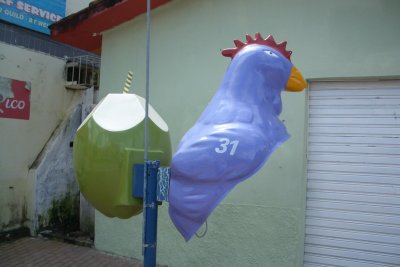
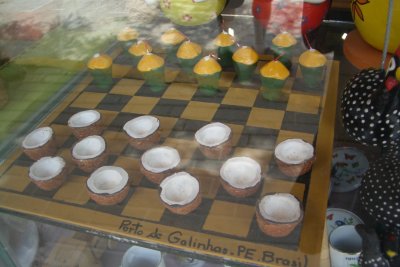 We did find a few nonchicken items, like this checker set featuring green and ripe coconuts and a fishnet "beach cover-up" that covered pretty much nothing—apparently etiquette sometimes demands that you cover your shoulders and midriff, if only with a few widely separated stands of thread). Some shops also sold raw sugar in various forms (definitely a local product). At one open-air eatery (empty at that time of the morning), a pair of life-size stuffed fabric tourists were seated at a front table, presumably as decoys to lure the real tourists in later.
We did find a few nonchicken items, like this checker set featuring green and ripe coconuts and a fishnet "beach cover-up" that covered pretty much nothing—apparently etiquette sometimes demands that you cover your shoulders and midriff, if only with a few widely separated stands of thread). Some shops also sold raw sugar in various forms (definitely a local product). At one open-air eatery (empty at that time of the morning), a pair of life-size stuffed fabric tourists were seated at a front table, presumably as decoys to lure the real tourists in later.
We also had a chance to check out Brazilian beach-resort food. As one would expect, little ice-cream carts were being pushed around both the beach and the streets, and as in Recife, stands were selling both green coconuts with straws and pineapple pops. These latter are entire pineapples (on the smallish side, but still good-sized) trimmed of leaves and skin, wrapped in waxed paper, impaled on sticks, and lined up to await purchasers. I found the idea puzzling. Evening if I wanted to eat an entire pineapple as a beach snack, it didn't look practical, and indeed with the pineapples we find at Publix, it wouldn't be—too hard to gnaw the flesh off the core, so you'd get juice all over you and a million tough fibers stuck in your teeth. But these local pineapples, which we had many opportunities to try, because slices of them were offered at almost every meal, turn out to be better suited to consumption as pops. They're very sweet and juicy (but are clearly not the very yellow, slightly seedy, genetically engineered ones we get), but the flesh separates quite easily from the core, so it would, indeed, to practical to eat one off a stick.
While strolling among the shops, I spotted, in the distance, a cart doing a brisk business. It was equipped with a very large mesh trash container partly filled with what looked like corn husks, but it made a lot of noise—machine-shucked dried corn as a beach snack? But, no, the noice was made by a small, gas-powered (I assume) cane mill. When a customer arrived, the vendor fired up the mill and shoved in a couple of stalks of sugar cane. When they emerged from the other side, he folded them up and ran them through a second time. What remained after that was the debris I had mistaken for corn husks and was dumped into the bin. The juice the mill extracted was poured into a cup and presented to the customer. Someone in our group tried it and said it tasted pretty much as one would expect—like water with sugar in it.
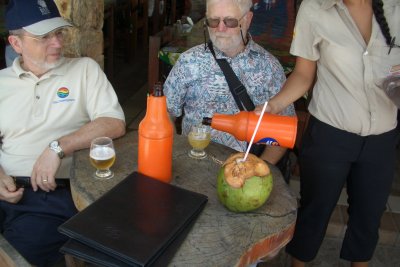
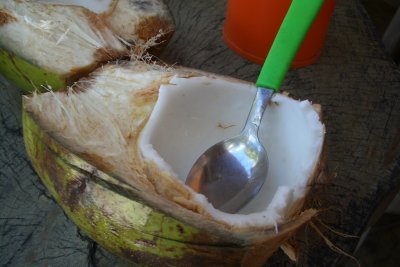 Toward lunchtime, we gravitated back to the restaurant and sat down to rest our feet. David and our friend Bill Hummon ordere beers, and I ordered coconut water, which I was pleased to find came in the coconut—my first chance to try it that way—and it was delicious! Much better than the glass of it I'd had at Fogo de Brasa. In addition, I could see through the hole the thin layer of coconut meat adhering to the interior of the shell, so when I finished the liquid, I pulled out my trusty Swiss army knife to see if I could get at it. No luck, whatever, the husk and shell were way too hard, but the waitress immediately came over and asked, in unmistakable pantomime, whether I'd like it opened. She took it away and returned moments later with the two halves, cleft from pate to chin, as it were, and a large spoon. The flesh was much thinner and softer than the meat of the mature coconuts we get here and much milder flavored.
Toward lunchtime, we gravitated back to the restaurant and sat down to rest our feet. David and our friend Bill Hummon ordere beers, and I ordered coconut water, which I was pleased to find came in the coconut—my first chance to try it that way—and it was delicious! Much better than the glass of it I'd had at Fogo de Brasa. In addition, I could see through the hole the thin layer of coconut meat adhering to the interior of the shell, so when I finished the liquid, I pulled out my trusty Swiss army knife to see if I could get at it. No luck, whatever, the husk and shell were way too hard, but the waitress immediately came over and asked, in unmistakable pantomime, whether I'd like it opened. She took it away and returned moments later with the two halves, cleft from pate to chin, as it were, and a large spoon. The flesh was much thinner and softer than the meat of the mature coconuts we get here and much milder flavored.
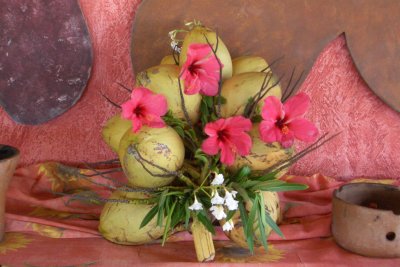
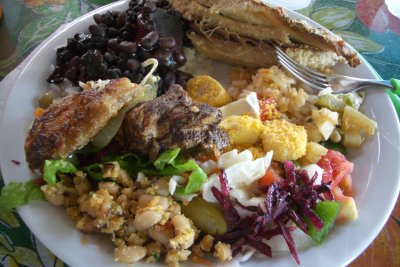 Around 1:00 p.m., they finally laid out our prearranged buffet lunch, around this handsome coconut-and-hibiscus centerpiece (with oleander trim). The serving trays were set on top of a mismatched set of pottery warming devices. I peaked inside before the trays arrived, and each pottery device contained about a 3-inch chunk torn from a bread baguette—I thought maybe the bread was being used as makeshift stoppers to keep cans of sterno from evaporating, but when the time came, the serving staff rolled up scraps of paper, lit them, and threw one in on top of each chunk of bread before setting a loaded serving tray on top. Any of you readers out there (yes, both of you) care to speculate on why? I haven't a clue.
Around 1:00 p.m., they finally laid out our prearranged buffet lunch, around this handsome coconut-and-hibiscus centerpiece (with oleander trim). The serving trays were set on top of a mismatched set of pottery warming devices. I peaked inside before the trays arrived, and each pottery device contained about a 3-inch chunk torn from a bread baguette—I thought maybe the bread was being used as makeshift stoppers to keep cans of sterno from evaporating, but when the time came, the serving staff rolled up scraps of paper, lit them, and threw one in on top of each chunk of bread before setting a loaded serving tray on top. Any of you readers out there (yes, both of you) care to speculate on why? I haven't a clue.
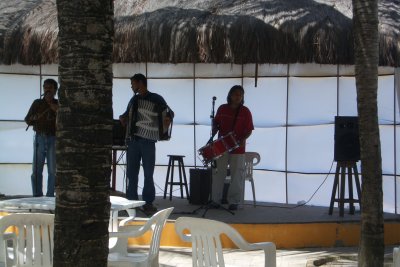 The restaurant was billed as a seafood place, but the buffet included feijoada and chicken as well as two kinds of fish. Nobody could tell me what the white-fleshed fish was (it was prepared in the usual way, i.e., floured, fried, and dressed with lime and capers), but several of the locals assured me that the other fish (roasted whole and presented with the heads on) was barracuda—I couldn't swear they were right, but it looked long, fast, and vicious enough to be. There were also several salads, a number of variations on Brazil's beloved farofa—toasted manioc flour mixed with black-eyed peas, with bananas, with vegetables, whatever—and the ubiquitous platters of tropical fruit (slices of pineapple, watermelon, papaya, guava, mango, grapes, etc.
The restaurant was billed as a seafood place, but the buffet included feijoada and chicken as well as two kinds of fish. Nobody could tell me what the white-fleshed fish was (it was prepared in the usual way, i.e., floured, fried, and dressed with lime and capers), but several of the locals assured me that the other fish (roasted whole and presented with the heads on) was barracuda—I couldn't swear they were right, but it looked long, fast, and vicious enough to be. There were also several salads, a number of variations on Brazil's beloved farofa—toasted manioc flour mixed with black-eyed peas, with bananas, with vegetables, whatever—and the ubiquitous platters of tropical fruit (slices of pineapple, watermelon, papaya, guava, mango, grapes, etc.
While we ate, a three-piece band set up in front of our terrace and played for the rest of the afternoon. To everyone's surprise (even some of the locals, I think), a thin, quiet girl who came down on the buses with us—one of the students who'd been manning the registration desk all week—got up and sang with the band! While we ate dessert, a heavy-set guy showed up, invited the band down off their little stage, and started working the crowd. Apparently, this is a favorite party passtime in Brazil—in Portuguese, he would ask people in the crowd where they were from or what they did for a living (the answers usually came from locals sitting nearby who knew them, since most of us didn't understand the questions), and depending on the answer, he would improvize (or at least piece together from a vast repertory) a few verses about them, mostly off color. All the Portuguese speakers would join in the refrain while he sought his next victim. He hit on Bill Hummon (obviously the oldest guy present) and brought down the house with a long and apparently ribald string of verses. (I asked one of the local students afterward what he'd said, and he told me, although with some embarrassment, since his English vocabulary was too limited to allow much in the way of euphemism. Here, I will simply render it "Just because there's frost on the roof doesn't mean there's no fire in the furnace.")
When lunch was over, David and I went for a long walk along the beach, waded in the surf, peered into tide pools, and so on. Interestingly, right down on the beach, the most popular snack food by far, judging from the number of carts, was "queijo na brasa," cheese on the coals, advertised as coming with molasses, oregano, and garlic sauce. Sure enough, when I finally spotted a serving being prepared, it was about a half-pound rectangular slab of firm white cheese (riddled with irregular holes, like acoustic ceiling tile), threaded end to end on a skewer, being browned over hot coals. I don't know whether the customer then chose one of the three toppings or it if was routinely served with all three.
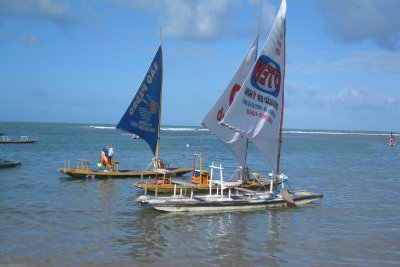 Some of our party took these little taxi-rafts (each seating 4 to 5 people) out to the outer reef to see the larger tide pools. Others settled on the beach to swim or sunbathe. Many struck deals with guys that I think of as "beach butlers." These are men who arrive at the beach in the morning with a hand-cart stacked with umbrellas and folding chairs. Each one sets up a cluster of typically 6-12 umbrellas, each shading 2-6 chairs, and awaits customers. For a small fee, you get rights to one of the umbrellas and its chair cluster, and the guy becomes your beach major domo. Want to go for a swim? He'll guard your beach bag. Friends show up to join you? He'll produce more chairs. Want a taxi-raft? He'll whistle one up. Want a drink (or a pineapple, or a slab of cheese)? He'll fetch it for you. You pay for everything through him, and he presumably gets a kickback from each vendor he takes your business to. Once I knew what to look for, I realized the beach in Recife works the same way—what David calls a full-service beach.
Some of our party took these little taxi-rafts (each seating 4 to 5 people) out to the outer reef to see the larger tide pools. Others settled on the beach to swim or sunbathe. Many struck deals with guys that I think of as "beach butlers." These are men who arrive at the beach in the morning with a hand-cart stacked with umbrellas and folding chairs. Each one sets up a cluster of typically 6-12 umbrellas, each shading 2-6 chairs, and awaits customers. For a small fee, you get rights to one of the umbrellas and its chair cluster, and the guy becomes your beach major domo. Want to go for a swim? He'll guard your beach bag. Friends show up to join you? He'll produce more chairs. Want a taxi-raft? He'll whistle one up. Want a drink (or a pineapple, or a slab of cheese)? He'll fetch it for you. You pay for everything through him, and he presumably gets a kickback from each vendor he takes your business to. Once I knew what to look for, I realized the beach in Recife works the same way—what David calls a full-service beach.
Interestingly, one thing Brazil's beaches don't have is seagulls. I watched carefully for days, and we saw sparrows and pigeons on the beach, but neither in Recife nor at Porto de Galinhas did we see one single seagull, tern, or sandpipery kind of thing. Baffling. They also have precious little shipping. In a week of looking out a 12th-floor window, we saw exactly one mostly empty container ship go by, and one small sailboat. All that open ocean, and all that wind, and (aside from the little taxi-rafts, which are specific to Porto de Galinhas) nobody is taking tourists out for sailboat rides—can the sharks really be that bad!?
Back at the restaurant terrace, the band was still playing, and people were dancing—both members of our party and others who just happened by. Watching the Brazilians dance was an education in itself. We saw several different dances, including the very popular "forro" (pronounced foho). All were done in standard "ballroom position," but in a very particular style—the dancers' heads and shoulders glides serenely around the floor, without a hint of sway or up-and-down motion, but from the waist down, they were dervishes of motion! Feet, legs, and hips swivelled amazingly, almost hula-like, partners in perfect unison—the effect was almost cartoon-like.
Meanwhile, men and, especially, boys about 14 years old, strolled the streets and circulated among the tables carrying bundles of fresh, green palm-frond strips, which they would fold and weave, as they strolled or before your eyes at tableside, into roses, angelfish, grasshoppers, and in one case I saw, a rose being visited by a hummingbird! The strips were precut, and all other cutting, shaping, etc. was done on the spot with fingers and teeth. I didn't price the little woven products, but they proved very popular, and quite a number of them came back with us on the bus, where a main topic of conversation was how to pack them for the flight home.
Back in Recife, we were at liberty for dinner, so we set off with friend and colleague Kevin Carman and wound up back at Fogo de Brasa, where we had, for my money, by far the best churrasco of the trip. All in all, I like their salad bar better, too, than Boi Preto's. The meat was the main show, though, and it was excellent, plentiful, and markedly less cooked than that at Boi Preto—important when you're dealing with grass-fed beef, which dries out and toughens quickly if cooked too long. In addition to the great pork ribs, chicken hearts, sausages, chicken legs, chicken breast chunks wrapped in bacon, and many other cuts of beef, including the legendary picanha, we discovered "filet de costela"—huge slabs of beef ribs, slow-roasted whole on the bone. Wow! When it arrived, on a wheeled cart because it's too big to roast on a skewer, I automatically specified "mal passada," but there's no such thing. It had been roasted well done but had remained moist, tender, and succulent, almost like pot-roast. The waiter cut each of us a slice, perpendicular to the ribs, from the 2-inch-thick layer of meat and fat on top of the ribs, and and zowie was it good!
I have since done a good deal of research on the internet and in my food-related reference books, and I've nailed down "picanha." It's the whole, untrimmed tri-tip, which is wide and flat, with a layer of fat on top. For churrasco, it is thickly sliced, each slice is curved into the shape of a "C" with the fat on the outside, and several such slices are threaded, edgewise, as it were, onto the skewer, like a column of C's. It seems to be considered the cream of the churrasco menu, and just as soon as I can locate some (my supermarket gets its tri-tip already trimmed and thinly sliced), I plan to try making it. For the ribs, I went to the supermarket and had a long talk with a friendly butcher there. From my descriptions and comparisons of the various cuts in his meat case, we figured out that the filet de costela must be uncut shortribs. He brought out an industrial-size package of shortribs as they arrive at Publix, which contained four square slabs, each 4 or 5 ribs wide and having, on top of the ribs, that nice layer of meat and fat. He sold me one of teh squares, untrimmed and with the fat still on top, which I took home, sprinkled liberally with coarse salt, and roasted for 5 hours at 250 degrees F (that's in my convection oven; in a conventional oven, you'd probably want to use 300 or 325 degrees). It was delicious at 3 hours and continued to improve thereafter—definitely a welcome addition to the home culinary repertory!
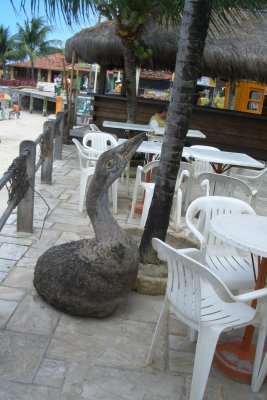 And just to prove that somebody in that town was bored with chickens, this elegant palm-tree-base bird (a cormorant, I guess) graced the restaurant's terrace.
And just to prove that somebody in that town was bored with chickens, this elegant palm-tree-base bird (a cormorant, I guess) graced the restaurant's terrace.
previous entry
List of Entries
next entry

 Now when you set out to build a name as a beach resort, you need a trademark theme, and somehow "last slave port in Brazil" didn't seem right, but chickens, now—everybody likes chickens! So chickens it is. Everything in town is shaped like, or decorated with, chickens (except the public trash containers, which are shaped like seashells). Some are faithful to the globular shape and black-speckled-with-white color scheme of guinea fowl, but apparently any old kind of chicken will do. You can buy carved chickens (of all sizes and shapes), stuffed chickens (ditto), chicken fridge magnets (double ditto), dozens and dozens of different patterns of chicken-bedecked t-shirts, chicken buckets and spades, chicken chess and checker sets, chicken-headed bar tools and fondue forks. The restrooms are marked with fanciful pictures of
roosters and hens. Palm-tree bases carved into the shapes of chickens are everywhere (here are a couple, with David next to one for scale). Some of the phone booths are shaped like chickens (rather malevolent-looking ones, I thought; here one shares a pole with another of those coconut shaped ones). Strangely, there's no KFC or local equivalent that I could spot, and we saw no actual live chickens (seems as though a few free-run jungle fowl would be a natural, like the ones at the San Diego Zoo, which patrol the paths for edible litter, like french fries and popcorn).
Now when you set out to build a name as a beach resort, you need a trademark theme, and somehow "last slave port in Brazil" didn't seem right, but chickens, now—everybody likes chickens! So chickens it is. Everything in town is shaped like, or decorated with, chickens (except the public trash containers, which are shaped like seashells). Some are faithful to the globular shape and black-speckled-with-white color scheme of guinea fowl, but apparently any old kind of chicken will do. You can buy carved chickens (of all sizes and shapes), stuffed chickens (ditto), chicken fridge magnets (double ditto), dozens and dozens of different patterns of chicken-bedecked t-shirts, chicken buckets and spades, chicken chess and checker sets, chicken-headed bar tools and fondue forks. The restrooms are marked with fanciful pictures of
roosters and hens. Palm-tree bases carved into the shapes of chickens are everywhere (here are a couple, with David next to one for scale). Some of the phone booths are shaped like chickens (rather malevolent-looking ones, I thought; here one shares a pole with another of those coconut shaped ones). Strangely, there's no KFC or local equivalent that I could spot, and we saw no actual live chickens (seems as though a few free-run jungle fowl would be a natural, like the ones at the San Diego Zoo, which patrol the paths for edible litter, like french fries and popcorn).
 We did find a few nonchicken items, like this checker set featuring green and ripe coconuts and a fishnet "beach cover-up" that covered pretty much nothing—apparently etiquette sometimes demands that you cover your shoulders and midriff, if only with a few widely separated stands of thread). Some shops also sold raw sugar in various forms (definitely a local product). At one open-air eatery (empty at that time of the morning), a pair of life-size stuffed fabric tourists were seated at a front table, presumably as decoys to lure the real tourists in later.
We did find a few nonchicken items, like this checker set featuring green and ripe coconuts and a fishnet "beach cover-up" that covered pretty much nothing—apparently etiquette sometimes demands that you cover your shoulders and midriff, if only with a few widely separated stands of thread). Some shops also sold raw sugar in various forms (definitely a local product). At one open-air eatery (empty at that time of the morning), a pair of life-size stuffed fabric tourists were seated at a front table, presumably as decoys to lure the real tourists in later.
 Toward lunchtime, we gravitated back to the restaurant and sat down to rest our feet. David and our friend Bill Hummon ordere beers, and I ordered coconut water, which I was pleased to find came in the coconut—my first chance to try it that way—and it was delicious! Much better than the glass of it I'd had at Fogo de Brasa. In addition, I could see through the hole the thin layer of coconut meat adhering to the interior of the shell, so when I finished the liquid, I pulled out my trusty Swiss army knife to see if I could get at it. No luck, whatever, the husk and shell were way too hard, but the waitress immediately came over and asked, in unmistakable pantomime, whether I'd like it opened. She took it away and returned moments later with the two halves, cleft from pate to chin, as it were, and a large spoon. The flesh was much thinner and softer than the meat of the mature coconuts we get here and much milder flavored.
Toward lunchtime, we gravitated back to the restaurant and sat down to rest our feet. David and our friend Bill Hummon ordere beers, and I ordered coconut water, which I was pleased to find came in the coconut—my first chance to try it that way—and it was delicious! Much better than the glass of it I'd had at Fogo de Brasa. In addition, I could see through the hole the thin layer of coconut meat adhering to the interior of the shell, so when I finished the liquid, I pulled out my trusty Swiss army knife to see if I could get at it. No luck, whatever, the husk and shell were way too hard, but the waitress immediately came over and asked, in unmistakable pantomime, whether I'd like it opened. She took it away and returned moments later with the two halves, cleft from pate to chin, as it were, and a large spoon. The flesh was much thinner and softer than the meat of the mature coconuts we get here and much milder flavored.
 Around 1:00 p.m., they finally laid out our prearranged buffet lunch, around this handsome coconut-and-hibiscus centerpiece (with oleander trim). The serving trays were set on top of a mismatched set of pottery warming devices. I peaked inside before the trays arrived, and each pottery device contained about a 3-inch chunk torn from a bread baguette—I thought maybe the bread was being used as makeshift stoppers to keep cans of sterno from evaporating, but when the time came, the serving staff rolled up scraps of paper, lit them, and threw one in on top of each chunk of bread before setting a loaded serving tray on top. Any of you readers out there (yes, both of you) care to speculate on why? I haven't a clue.
Around 1:00 p.m., they finally laid out our prearranged buffet lunch, around this handsome coconut-and-hibiscus centerpiece (with oleander trim). The serving trays were set on top of a mismatched set of pottery warming devices. I peaked inside before the trays arrived, and each pottery device contained about a 3-inch chunk torn from a bread baguette—I thought maybe the bread was being used as makeshift stoppers to keep cans of sterno from evaporating, but when the time came, the serving staff rolled up scraps of paper, lit them, and threw one in on top of each chunk of bread before setting a loaded serving tray on top. Any of you readers out there (yes, both of you) care to speculate on why? I haven't a clue. The restaurant was billed as a seafood place, but the buffet included feijoada and chicken as well as two kinds of fish. Nobody could tell me what the white-fleshed fish was (it was prepared in the usual way, i.e., floured, fried, and dressed with lime and capers), but several of the locals assured me that the other fish (roasted whole and presented with the heads on) was barracuda—I couldn't swear they were right, but it looked long, fast, and vicious enough to be. There were also several salads, a number of variations on Brazil's beloved farofa—toasted manioc flour mixed with black-eyed peas, with bananas, with vegetables, whatever—and the ubiquitous platters of tropical fruit (slices of pineapple, watermelon, papaya, guava, mango, grapes, etc.
The restaurant was billed as a seafood place, but the buffet included feijoada and chicken as well as two kinds of fish. Nobody could tell me what the white-fleshed fish was (it was prepared in the usual way, i.e., floured, fried, and dressed with lime and capers), but several of the locals assured me that the other fish (roasted whole and presented with the heads on) was barracuda—I couldn't swear they were right, but it looked long, fast, and vicious enough to be. There were also several salads, a number of variations on Brazil's beloved farofa—toasted manioc flour mixed with black-eyed peas, with bananas, with vegetables, whatever—and the ubiquitous platters of tropical fruit (slices of pineapple, watermelon, papaya, guava, mango, grapes, etc. Some of our party took these little taxi-rafts (each seating 4 to 5 people) out to the outer reef to see the larger tide pools. Others settled on the beach to swim or sunbathe. Many struck deals with guys that I think of as "beach butlers." These are men who arrive at the beach in the morning with a hand-cart stacked with umbrellas and folding chairs. Each one sets up a cluster of typically 6-12 umbrellas, each shading 2-6 chairs, and awaits customers. For a small fee, you get rights to one of the umbrellas and its chair cluster, and the guy becomes your beach major domo. Want to go for a swim? He'll guard your beach bag. Friends show up to join you? He'll produce more chairs. Want a taxi-raft? He'll whistle one up. Want a drink (or a pineapple, or a slab of cheese)? He'll fetch it for you. You pay for everything through him, and he presumably gets a kickback from each vendor he takes your business to. Once I knew what to look for, I realized the beach in Recife works the same way—what David calls a full-service beach.
Some of our party took these little taxi-rafts (each seating 4 to 5 people) out to the outer reef to see the larger tide pools. Others settled on the beach to swim or sunbathe. Many struck deals with guys that I think of as "beach butlers." These are men who arrive at the beach in the morning with a hand-cart stacked with umbrellas and folding chairs. Each one sets up a cluster of typically 6-12 umbrellas, each shading 2-6 chairs, and awaits customers. For a small fee, you get rights to one of the umbrellas and its chair cluster, and the guy becomes your beach major domo. Want to go for a swim? He'll guard your beach bag. Friends show up to join you? He'll produce more chairs. Want a taxi-raft? He'll whistle one up. Want a drink (or a pineapple, or a slab of cheese)? He'll fetch it for you. You pay for everything through him, and he presumably gets a kickback from each vendor he takes your business to. Once I knew what to look for, I realized the beach in Recife works the same way—what David calls a full-service beach. And just to prove that somebody in that town was bored with chickens, this elegant palm-tree-base bird (a cormorant, I guess) graced the restaurant's terrace.
And just to prove that somebody in that town was bored with chickens, this elegant palm-tree-base bird (a cormorant, I guess) graced the restaurant's terrace.